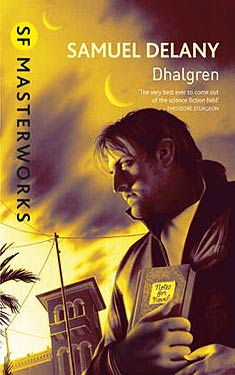Samuel R Delaney
Completed 3/31/2014, Reviewed 4/17/2014
4 stars
It took me nearly three weeks to read this 800 page
tome. When people asked me what it was
about, I usually said, “It’s about a drifter who ends up in Bellonia, a city in
the center of the U.S. ,
which seems to have experienced something apocalyptic. He’s a poet who becomes the head of a gang,
has a lot of sex, and, oh yeah, he might be schizophrenic. I’ve heard it’s kind of stream of conscious,
like Joyce’s ‘Ulysses.’” And when they
ask if this is one of my science fiction reads, I answer, “I think so?!”
“Dhalgren” is a very strange book. The main character is the kid, or The Kid, or
Kidd, so dubbed because he can’t remember his name. He’s drifted into Bellonia, where roads are destroyed,
houses burn one day and are fine the next, and only several thousand out of an
original several million people remain, living in communes, gangs, or desperate
solitude. Early on, we learn that Kidd
is bisexual, or perhaps more accurately, has a very fluid sexuality. He initially settles in with Lanya, living in
a commune in one of the town’s parks.
Eventually, he hangs around with the gang known as the scorpions, moving
in with them and becoming their leader.
He acquires another lover, a teen named Denny, with whom he and Lanya
form a polyamorous relationship. Kidd is
also a poet. Upon arriving in Bellonia,
he acquires a notebook that has all the right side pages written in. Kidd writes his poetry and keeps a journal on
the left side pages. He goes from
situation to situation, documenting his experiences in this odd city,
eventually becoming a kind of folk hero, despite the fact that he walks around
with one bare foot and occasionally wakes up not remembering anything that
happened to him in the last week.
What’s most interesting about the book is that there’s no
plot. It’s more like a collection of stories
about an odd person in a strange place.
It really is like a journal. Delaney
is playing with form, giving the reader characters, mood, and events, but no
real direction besides the passing of time.
And there’s a meta- or circular quality to the book. It begins with a prosaic passage, which later
we find is a passage from the notebook. With
Kidd’s blackouts, it is unclear if the passage is from another author or his
own writing from one of his schizophrenic episodes. Moments of ornate prose in first person
appear in the midst of straight-forward third person narration. One chapter of the book is presented as if it
has been transcribed from the journal, with multiple entries appearing in the
text, indicating multiple thoughts and timelines. If you get caught up in the structure of the
book, it can be quite difficult to get through.
I had moments when I was confounded by it.
But the book was very readable. At some point, I just let it be an
experience. The book never felt like
something to trudge through. It became
something akin to voyeurism. I never
wanted to put it down, and despite the three weeks it took me to read, I didn’t
really want it to end. The characters
are drawn in great detail. Except for
the myriad of gang members, I had distinct pictures and senses of almost
everyone in the book.
There is a lot of sexuality in the book. As mentioned before, the main character is
bisexual, and there are gay and Lesbian characters as well. Initially, all the explicit sex feels gratuitous. As I say, there’s a lot of it. But as the book progresses, it simply becomes
a normal part of the narrative. I
wondered if the point was that it shouldn’t be shocking, but integral. Sex is normal and an important part of a
person. Just as any other part of this
book reveals insight into the life and mind of the Kid, so does his sexuality.
The most confusing part of this book was deciding whether or
not this was SF. It’s considered a
classic SF novel. I think today, it
would be considered post-apocalyptic speculative fiction. I wondered if Delaney’s real premise was that
he wanted to write about an alternative society where government has broken
down, sexuality is not an issue, and then extrapolate on how people would
respond. To ground it in SF, he added a
double moon and a giant sun. I think if
he wrote it today, he wouldn’t have needed these conceits. It would have fit into the more general
speculative genre. But for 1976, it was
needed to allow him to explore people in a social situation simultaneously unlike
1976.
A lot of people have written that “Dhalgren” is unreadable,
or terse or dry at best. Others say it’s
a masterpiece of contemporary literature, not meant to be understood upon the
first read. I certainly don’t know what
it was really about. I’m sure there’s a
ton of symbolism I missed. But I really
enjoyed it. If you intend to read this
book, I suggest you need to be open to a creative literary style and to an
imaginative contemplation of the daily lives of a small group of people dealing
as best they can in a bizarre situation.
Oh yeah, and not be afraid of sex.
I give it 4 stars.

Your link at WWend brought me here. I've just started reading Dhalgren, with uncertainty for the unconventional style. Thanks for the encouraging review.
ReplyDeleteHey Buck, I'm glad you found this helpful. The deeper I got into the book, the more I searched for reviews to help with understanding it. I was grateful for both the positive and negative reviews I found because they both gave me insight into the form as well as the story. Good luck!
Delete